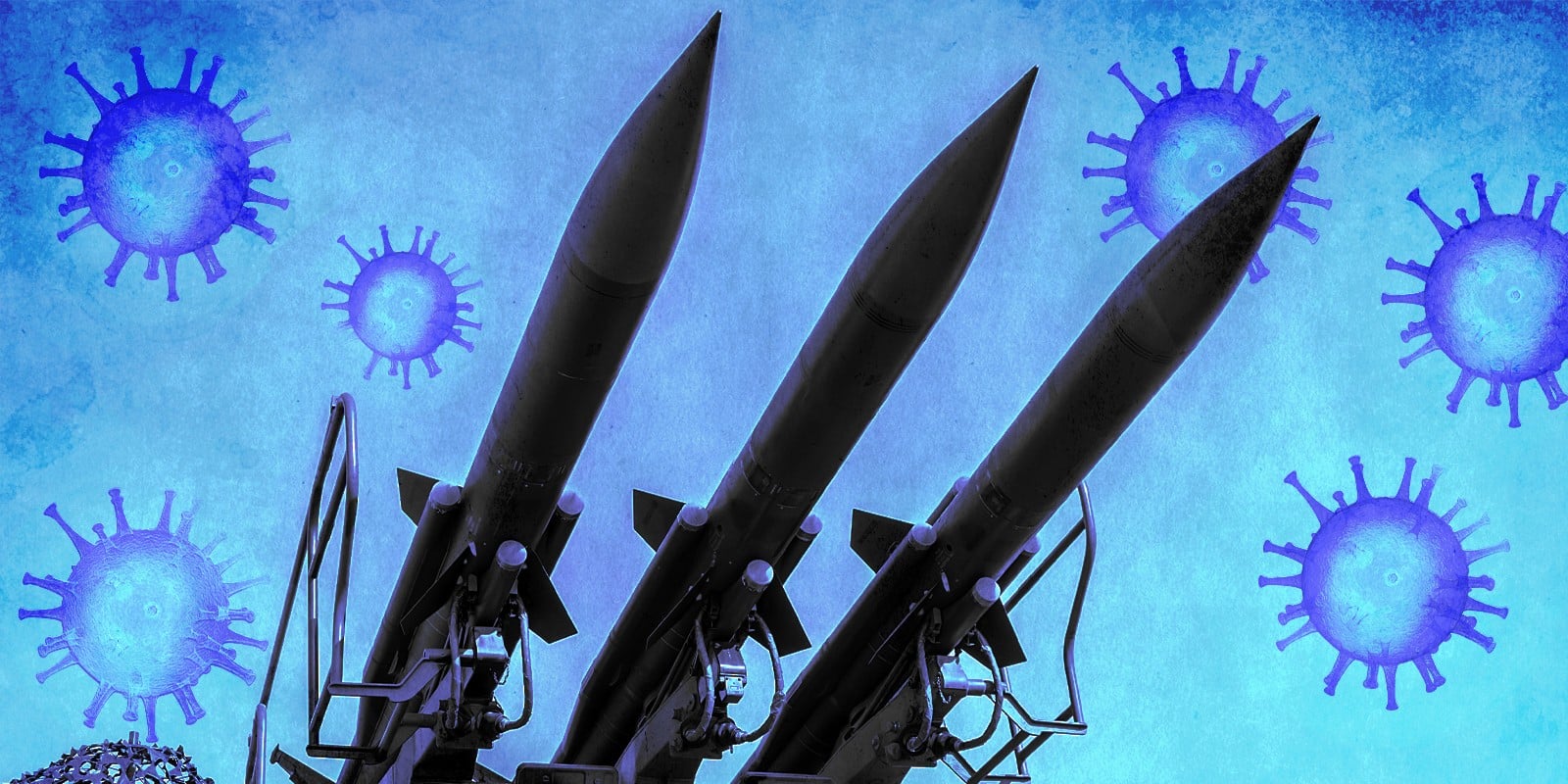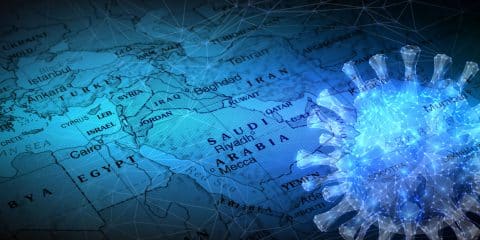The lesson learned from the current crisis is that restrictions imposed to protect the public are futile unless the public is convinced that it is at risk. To this end, government must communicate to the public with clear-cut data and logical arguments.
The COVID-19 pandemic, popularly known as the “corona pandemic” (my apologies to the manufacturer of the famous beer) struck Israel over three months ago. This led to unprecedented measures never before encountered such as the closing of schools and businesses, and even a curfew that reminded those old enough to remember the days of the curfew imposed by the British Mandate authorities. Intended to slow the spread of the virus these measures caused a deep economic crisis and unemployment of about one quarter of the workforce. The COVID-19 pandemic is undoubtedly a life-altering event bordering on a disaster of mass proportions. Mass disasters are the nightmare of leaders and politicians and daily fodder for prophets of doom and sci-fi lovers. Mass disasters that occurred in recent decades – Chernobyl, Fukushima, the tsunami in South-East Asia – appear small compared to the fertile imagination of the genre lovers, from the life-annihilating impact of asteroids, through monstrous volcanic eruptions to pandemics that wipe out most of humanity except for a special few that manage to survive and repopulate the earth, alluding to the story of the flood. Another type of mass disaster that concerned members of the scientific community up until recently was a nuclear winter in the aftermath of a nuclear war. The attention of this community has now shifted from the danger of war to the danger of peace: from the outcomes of a nuclear war to the outcomes of global economic prosperity that causes exponential growth in energy consumption, and hence to global warming.
Up until now Israel had focused its attention on three types of mass disasters which it considered as having more than minimal probability: an earthquake due to the proximity to the Syrian African fault, a global virus pandemic that would spread to Israel, and a war in which the civilian population would be heavily bombed, with heavy casualties and fatal economic damage. The Middle East has sustained an abundance of earthquakes. Several powerful earthquakes destroyed entire cities in the Land of Israel, among them Tiberias and Beit Shean in the 8th century and Safed in the 19th century. Awareness of this danger is reflected, among other things, in a change of building regulations and in the National Outline Plan (Tama 38) that encourages strengthening buildings to withstand earthquakes. The danger of a local and global virus pandemic concerned Israeli governments in the past owing to the volatility of the flu that often reaches sub-pandemic proportions, as well as the periodic outbreak of new viruses in the world, such as Ebola, avian influenza and SARS, which fortunately did not spread to Israel. As for harm to the civilian population during war, in the opinion of many observers Israel was already on the verge of on mass disaster during the 2006 Second Lebanon War when entire cities in northern Israel emptied and economic activity in missile-stricken areas ground to a halt. Awareness to this type of mass disaster resurfaces with each new round of escalation with Palestinian factions against Israel that is followed by missiles fired at southern and central Israel.
It is an historical irony that the latest mass disaster is of all things a global virus pandemic, which certainly surprised all those – together with most of the country’s citizens – who expected the next mass disaster to be a war with the Hezbollah. There are undoubtedly major differences between a virus pandemic and a missile attack on the civilian population, but there are also certain similarities. Although Israel is still in the midst of a pandemic whose end (if at all) remains unknown, I think that we can already draw some insights about other mass disaster scenarios, particularly a missile attack on civilian targets.
We begin by identifying the differences between a pandemic and a missile attack. First, a pandemic causes death but does not damage property, while a missile attack causes both. Second, a pandemic spreads and grows by infecting other people and therefore the initial threat is internal because in the first stages of a pandemic, when virus carriers cannot yet be identified, anyone in the community is a potential threat to anyone else. In a missile attack the threat is external and all community members have the same common enemy. Third, since the end of the 19th century humanity successfully ended many pandemics by developing medications and vaccines. Therefore, it is reasonable to assume that the coronavirus pandemic will also ultimately be eliminated. Missile attacks by contrast are part of armed conflicts, and it is doubtful whether humanity will ever be able to put an end to war. Unfortunately, there is no medicine or vaccine that will end wars and missile attacks once and for all.
The most fundamental difference between a pandemic and a missile attack on the civilian population is at the crisis management level: in the modern age humanity is more accustomed to wars than to pandemics. All countries in the world have key organizations for integrated resource management during wartime: cabinets, defense ministries, army general staffs and more – but there are no organizations charged with national resource management and coordination during a pandemic. As noted in a recently published New York Times article: “The U.S. does not have a Pentagon against viruses.” The problem also goes beyond just the management of medical resources. Even Britain’s National Health Service (NHS), perhaps the most centralized public health service in the western world, only manages medical resources, but not the other ramifications of the pandemic.
As in war, thus in a pandemic. Not only the on the public health level, but also its consequences and implications such as the economy, foreign affairs and internal policy must be closely managed. In managing a crisis, a cabinet is tasked with integrating the national effort. However, up until recently a dedicated government entity responsible for dealing with a pandemic did not exist in Israel. (The “corona cabinet,” established by the current government, is an interesting innovation whose efficacy has yet to be proven). In war the army general staff deploys forces in a centralized manner and the Defense Ministry centrally operates industrial resources. There are no equivalent entities for managing a pandemic. In contrast to the Ministry of Defense, the Ministry of Health is a regulatory agent, that does not directly operate the healthcare system. The healthcare organizations (HMO’s) comprise the “army” that directly fights the pandemic. Civilian entities that do not have a Chief of Staff at their helm and, unlike military organizations, are not required to follow orders. This is only a statement of fact, and in no way should be construed as implying or recommending that the current situation requires a change.
There are also similarities between the effects of a pandemic and that of a missile attack. First and foremost, both types of disaster create panic and a sense of terror amongst the entire population. The virus, like the missile, does not distinguish between people. No one knows how many will be hit, and no one can be sure that they or their family will not be hurt. An Arab folk story from North Africa tells what happened to the inhabitants of a village when they heard that the angel of death would visit one of the village families in two weeks’ time. A delegation sent the village elders to investigate the matter reported upon its return that it had verified that indeed the angel would soon visit one of the village homes, but it could not ascertain exactly which family would “earn” the visit. The result was that entire village packed up and fled. This allegory captures the essence of the term “terror”: generating indiscriminate panic. In terms of public anxiety, it is immaterial whether the “angle of death” materializes in the form of a virus or a missile.
A second similar characteristic is difficulty protecting the population. When the new viruses of recent decades erupted – HIV, Ebola, avian influenza, SARS, and now COVID-19 – there were no effective medicines or vaccines, and until these were perfected the entire population was in danger. In the scenario of a missile attack, while there is “medication” in the form of missile defense systems, the defense is not hermetic and the danger of loss of life due to failed interception of missiles is always present. In both scenarios the way to reduce casualties is to disperse the population and prevent concentration of people in schools, industries, shopping centers and entertainment venues (except for gathering in protected spaces in the missile attack scenario). The inevitable outcome in both scenarios is decreased economic activity, reduced income to many, and severe damage to the national economy. In both cases protecting the population and preserving the economy are mutually exclusive goals. One comes at the expense of the other, a classic zero-sum game.
The third similar characteristic is uncertainty regarding the crisis duration. A missile attack is a military operation that may be part of a larger all-out war. Wars do not have a pre-determined end date, and those involved in a war have no way of knowing when it will be over. Similarly, the pandemic of a new virus does not have an end date that can be predicted with any degree of certainty, because it is impossible to know how long it will take to develop an effective medicine or vaccine.
In both scenarios the crisis takes place under conditions of uncertainty regarding its course, duration and measures that should be taken to minimize casualties and damage. Past experience – based on previous missile attacks or virus pandemics – is of limited relevancy, because every crisis has its own distinct characteristics, such as the identity of the enemy and type of missiles in its arsenal in the current round, or the identity of the virus and the effects of the current pandemic. In a pandemic as in war, managing the crisis requires two things. First, integrated crisis management by the government and its institutions. Second, public willingness to cooperate with the government and bear the unavoidable personal and economic burden. The quality of the government’s integrated crisis management, and the degree of public cooperation, ultimately determine the degree of success on overcoming the crisis.
Despite the differences between the two scenarios, the few common features between them can provide some lessons from the management of the COVID-19 pandemic to the ability of the government and the public to weather other mass disaster crises, including a missile attack on the civilian population.
As indicated above, the only way to contend with the pandemic at the stage in which there is no medicine or vaccine is to prevent gatherings to reduce the rate of infection, thereby curtailing economic activity. This has been and continues to be, the dilemma facing all world governments. Each government chose its own trade-off between disease incidence and the economy. China, which was the first to be hit, chose to reduce disease incidence at the expense of the economy, and was very successful at this. Other countries, for example Sweden (to-date) or Britain (in the initial stages of the pandemic) gave priority to the economy and paid a price in the high infection and death rates. The government of Israel initially chose a strategy of reducing infection at the expense of economic activity. Prime Minister Benjamin Netanyahu, who espoused the role of the national information provider, set a goal of “protecting grandmother and grandfather” and “flattening” the growth curve of COVID-19 infection, so as not to overwhelm the healthcare system. As part of this policy, at the beginning of March strict lockdown orders were imposed on the public and most economic activity was halted, culminating in a complete curfew on the two days of Passover, in Independence Day and on Lag BaOmer, and a partial curfew during the Muslim Ramadan holiday. These measures led to an economic crisis and to about one million unemployed but succeeded in reducing the infection rate to almost total suppression.
About five weeks later, in mid-April, the government began to ease the restrictions and to allow a gradual resumption of economic activity – initially reopening stores, and about one month later – in mid-May – reopening schools. While remaining undeclared, the policy shifted from prioritizing infection rate to prioritizing the economy. The partial economic recovery was achieved at the price of accelerated infection, and at the time this article is written some of the planned relief measures have been halted (mainly air travel), and the Prime Minister hinted at the possibility of re-imposing some of the previous restrictions.
In the first weeks of the crisis public willingness to cooperate was evident, with no significant protests against the curtailment of personal freedoms and harm to people’s loss of livelihood. There have been sporadic incidents of active opposition, for example among extreme Jewish ultra-Orthodox factions that refused to stop congregating in synagogues and funerals, small demonstrations of leftist circles protesting human rights violations, and refusal of fun lovers on Tel Aviv beaches to limit their freedom to have a good time – however most of the public complied with the social isolation and curfew restrictions, despite the entailed difficulty. Two factors may explain this. First – the sense of a real threat, mainly in light of frightening reports of the toll of the pandemic in Italy and Spain. Second – the economic easing measures the government took, mainly abandoning the balanced budget principle while providing the needed financial assistance to businesses and the unemployed. (In other words, printing as much money as needed.)
It appears that the changing priorities from infection rate to the economy stemmed from media pressure (which perhaps reflected public opinion) rather than from rigorous risk management. The Health Ministry opposed the rapid rate of the easing measures out of concern for the infection rate – most likely correctly. However, the Prime Minister overruled this. The reason for the erosion of public willingness to sustain the restrictions (or, to use a more academic term – the reduction in “civilian resilience”) warrants in-depth research. The author’s impression is that this stemmed from a diminished sense of threat. The success of the social isolation policy, the declining number of those infected and the relatively small number of persons who actually died from the virus (to-date) compared to the frightening forecasts of tens of thousands of fatalities, generated a sense of a “false alarm” and the demand to return life to normal. Apparently, the Prime Minister could not withstand the pressure.
However, additional factors may explain the erosion of civilian resilience, among them the schism in Israeli society that led to “politicization” of the crisis, and to the claim by a large segment of the public that opposes the Prime Minister, that he intentionally amplified the crisis for his own political needs. Regardless of the reasons, it seems that the Prime Minister was more attentive to the desire of the public to return to normalcy that to his health experts, which was perhaps evident from his wishes to the public on the eve of the Shavuot holiday – “to have a good time.” The results, so far, are not encouraging, to say the least. At the time this is written general opinion is that a return to the social isolation restrictions as they were imposed at the outset of the crisis would encounter resistance from a large part of the public. Accordingly, the next wave of infection may be worse than the first one.
What can be inferred up to now from the COVID-19 pandemic about a security crisis? As indicated above, successful crisis management depends on both the functioning of the government and public willingness to bear the burden. Regarding the former, it should be taken into consideration that the government of Israel – like most governments in the world – does not have a “public health defense ministry.” The possibility of a virus pandemic in Israel was already addressed by the government of Ariel Sharon in 2006, which at the time decided that such a crisis would be managed by the Defense Ministry through the Home Front Command, with the Health Ministry serving as the professional authority on health issues. In other words, it decided not to establish a “Public Health Defense Ministry” with independent operational capabilities, but rather to manage health crises through existing government agencies granted execution abilities to deal with general emergencies. Prime Minister Netanyahu decided not to follow this policy, instead choosing in effect to manage the current health crisis personally, assisted by the National Security Council (NSC) for staff work. Netanyahu used the Defense Ministry not as a management agency but as an executive for specific tasks (e.g., procurement and manufacturing ventilators).
Why did the government decide to ignore the 2006 decision, and did this impair the quality of its crisis management? In hindsight, the 2006 decision may have been a priori erroneous, and a health crisis of such colossal proportions, that can easily turn into a mass disaster, must be managed by the highest authority in the state – in other words the Prime Minister and the Prime Minister’s Office. Nevertheless, the decision to depart from the 2006 determination will become a likely focus of debate and research in the future.
As for the public’s willingness to bear the burden – in other words, “civilian resilience” – it appears that we can infer from the pandemic scenario to a war scenario. The question of “civilian resilience” in a national crisis is being widely investigated by research institutes around the world. In Israel, the main research is currently conducted by Brig. Gen. (res.) Dr. Meir Elran from the Institute for National Security Studies (INSS). A review of studies about “civilian resilience” indicates that it depends, inter alia, on the balance between the level of threat perception and fear of consequences on the one hand, and the price the public is required to pay in personal suffering and loss of income on the other hand. The greater the sense of threat, the greater the public’s willingness to bear the burden.
It appears that in the initial stages of the current crisis the sense of threat was sufficiently strong to cause the public to accept the restrictions. The weakening of this sense of threat is now eroding the readiness of the public to cooperate. Why did the sense of a threat diminish? It is reasonable to assume that one of the main factors is the (relatively) small number of COVID-19 victims to date. A similar phenomenon was also evident during the missile attacks from Gaza, beginning with Operation “Protective Edge” (“Tzuk Eitan”) and throughout the rounds of escalation that followed. The success of the active defense systems in reducing casualties diminished the sense of a threat and created a false sense of security. Many in the public violated Home Front Command orders and left their protected spaces to relax and watch the missile defense systems in action, which resulted in a considerable number of casualties.
The lesson from the current case is that orders issued to protect the public are not sustainable unless the public is convinced that it is in danger. This requires government agencies to explain their decisions by presenting clear-cut data and logical arguments, as exemplified by the IDF Spokesperson, Nahman Shai, during the 1991 Gulf War. Part of the eroding sense of a threat may not only stem from the gap between severe predictions and reality, but also from harsh criticism expressed by experts and pundits about the severity of the threat, such as the argument that “corona is merely the flu with public relations,” or the analysis of professors Doron Lancet and Itzhak Ben-Israel (Ynet, June 10, 2020) which claimed that the increased number of infected individuals does not reflect reality, and that most of those defined as “infected” cannot infect others. If the managers of the present crisis – the Prime Minister, the National Security Council (NSC) and the Health Ministry – think otherwise, their voice has not been heard sufficiently to date.
In general, the Israeli public does not tend to accept discipline, to say the least, but is willing to be persuaded. If the government thinks that there is a significant threat to the public – whether a health or a security risk – it must convince the public with arguments no less detailed that those of the critics, and by means of spokespeople whose professional authority and expertise is not inferior to that of the critics. We can learn from the current crisis about the critical importance of the messages conveyed by the government managing the crisis to the public that must withstand the crisis. This lesson holds true for a health crisis, and even more so in a security crisis such as an extensive missile attack on the civilian population.
Despite the sense of complacency among the public at the time this article is written, we are still in the midst of the crisis, and it is entirely uncertain whether the danger of a mass disaster has passed. It is also still premature to draw detailed conclusions at a high confidence level. The description above is, as noted, only an initial impression. Israel must wait and see how the current crisis develops, and hope for its rapid end.
JISS Policy Papers are published through the generosity of the Greg Rosshandler Family.
Photo: Freepik









 - בניית אתרים
- בניית אתרים